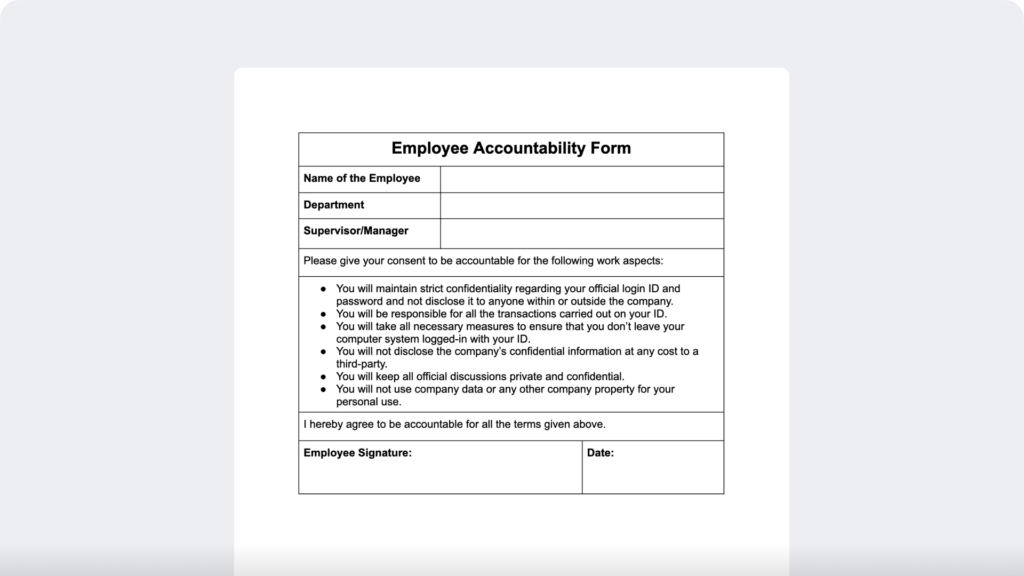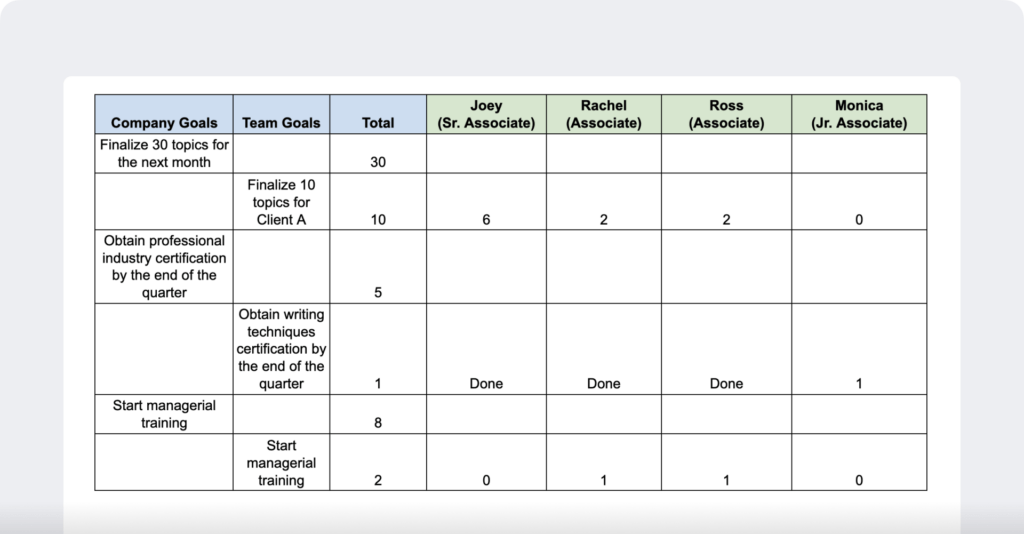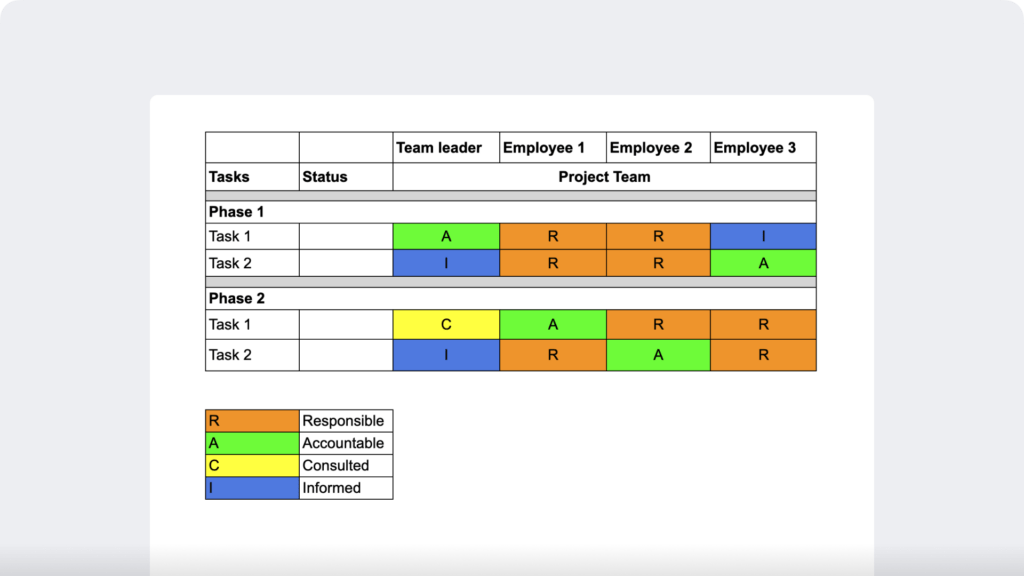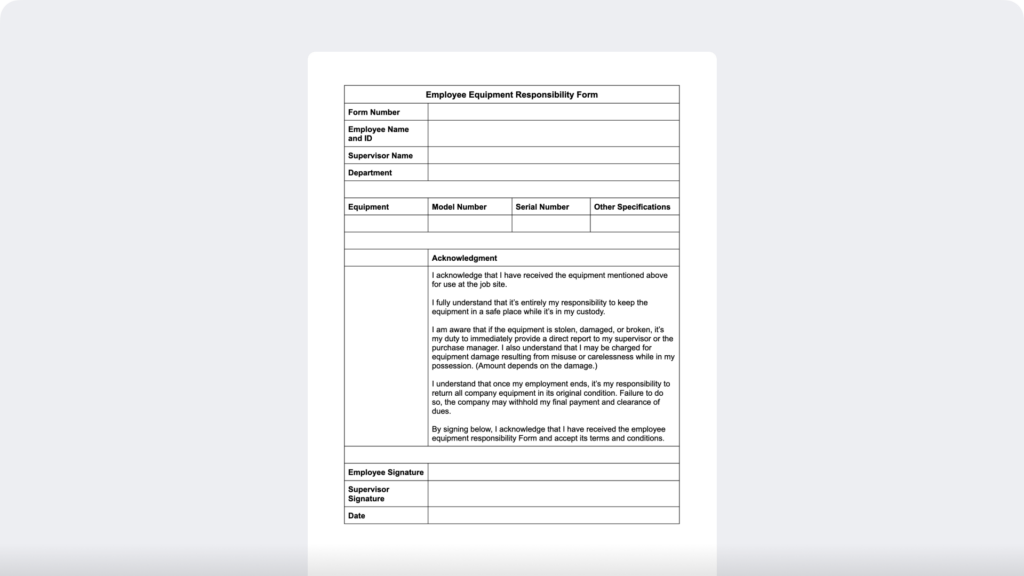Looking for an employee accountability template?
Holding employees accountable for their actions may seem daunting, especially if you’ve just been promoted to a managerial position or are a new business owner.
But how do you hold an employee accountable?
In this article, we’ll share smart strategies for increasing employee accountability. We’ll also provide four employee accountability templates that you can customize for your needs.

Table of Contents
- What is employee accountability?
- 4 excellent employee accountability templates
- Consequences of poor employee accountability
- Technology tools to enhance employee accountability
- 6 smart strategies to increase employee accountability
Let’s jump right in.
What is employee accountability?
Employee accountability implies that all employees are responsible for their actions, decisions, performance, and behavior at the workplace.
Accountability is all about taking the initiative and ownership.
If an employee says that they’ll achieve specific goals, they need to fulfill their commitment within the stated time period and not pass it off as someone else’s responsibility.
This is important for the team to function smoothly since each team member is dependent on the other.
When each employee starts taking their own responsibility, they’re more likely to attain their individual goal.
There are four areas that are an integral part of managing employee accountability:
1. Communication
Communication can increase workplace accountability and the employees’ performance.
Using proper communication channels (instant messaging, email, etc.) in the right place helps to create a company culture that focuses on unity and openness.
2. Productivity
To enhance workplace accountability, ensure that employees take steps to increase their own productivity.
These may include – using productivity tools, increasing their knowledge, taking care of their wellbeing, etc.
3. Clear processes and workflows
As accountable leaders, managers need to ensure streamlined workflows and transparent work processes to increase employee accountability.
4. Supervision
Supervising your employee’s work at all stages will make them feel responsible for all they do (or don’t do!) It’ll also allow you to hold them accountable for their work.
However, ensure that you don’t end up micromanaging employees as that can lead to mistrust and undesirable employee behaviour.
4 excellent employee accountability templates
Once you’ve developed a favorable work environment, you need to use policies that’ll help you and your employees keep track of their responsibilities.
It’s beneficial to have templates for various accountability policies. These ready-to-use templates can be customized according to your needs.
Here are four sample templates for implementing employee accountability in your company:
1. Employee accountability form template
The main aim of this form is to get formal consent from a new employee during onboarding. Here, the employee agrees to adhere to the company’s rules and regulations.
The employee accountability form enlists all the company guidelines that they need to follow under all circumstances.
This template may be particularly useful for remote work.
Let’s take a look at this employee accountability template:

Download it here: Employee Accountability Form Template
Disclaimer: This employee accountability form template is meant to be a general guide only and should be used only as a reference. The template may not necessarily include all local, state, or federal laws and other applicable laws, and hence, it should not be considered a legal document. Neither the author nor Time Doctor shall be responsible for any legal liability that may result from the use of this sample employee accountability form.
2. Task completion form template
The task completion form is an organized way of tracking the company’s and team’s goals.
It provides a breakdown of the specific goals that need to be completed by the accountable employees within a certain time period.
Here’s a template to help employees keep track of their personal accountability:

You can download it here: Task Completion Form Template
3. RACI chart template
If you or your employees aren’t clear about who’s responsible for a particular objective, it can be difficult to enforce accountability.
Additionally, it gets easier to pass the blame if something goes wrong.
To avoid this, you can make use of accountability frameworks like the RACI matrix. It ensures that all human resources associated with the project are assigned a role throughout the process.
RACI is an acronym for:
- Responsible: Shows the accountable employees for the task at hand.
- Accountable: Consists of those in the leadership role, accountable for the completion of the tasks and delivering the key results. This individual may also be responsible for delegating work.
- Consulted: These individuals are the subject experts on the task at hand. They’re involved only at a specific stage of the project as consultants or advisors.
- Informed: These are the higher-up authorities who are given updates on the progress of the project at each stage.
Clearly defining roles can make it easier for you and the employees to check-in on the person accountable for that particular task.
Here’s a sample:

You can download it here: RACI Chart Template
4. Employee equipment responsibility form template
Managing the company’s equipment may prove to be a burden, especially if you’re unsure which tool has been issued to a certain employee.
The equipment responsibility form helps you keep track of your equipment inventory.
It’ll also outline the rules that need to be followed by employees when using any company equipment.

You can download it here: Employee Equipment Responsibility Form Template
Disclaimer: This employee equipment responsibility template is meant to be a general guide only and should be used only as a reference. The template may not necessarily include all local, state, or federal laws and other applicable laws, and hence, it should not be considered a legal document. Neither the author nor Time Doctor shall be responsible for any legal liability that may result from the use of this sample employee equipment responsibility form.
Consequences of poor employee accountability
Managers may not always be strict about holding employees accountable for their work since they can be hesitant to confront them.
However, this may prove to be unproductive for the company’s success.
If managers tolerate missed deadlines, unfinished projects, lack of punctuality, etc., their subordinates are bound to feel that their laid-back attitude is a part of the company culture.
However, it’s a big problem for those accountable employees who are punctual and sincere about their work.
It may affect the overall efficiency and functioning of the team. It can also lead to resentment for that employee and the manager as well.

Technology tools to enhance employee accountability
Modern employee accountability can be greatly enhanced with the help of technology, especially for remote or hybrid teams. Here are a few tools that can assist managers in tracking tasks, performance, and goals:
- Time Doctor: Our workforce analytics software helps managers monitor employee productivity by tracking time spent on tasks and projects. It provides detailed reports on work habits, helping managers identify areas for improvement and hold employees accountable for their time management.
- Trello: A popular project management tool that allows teams to create boards for specific projects, assign tasks, set deadlines, and monitor progress. Its visual layout makes it easy to see who’s responsible for each task and track project timelines.
- Asana: Asana enables teams to organize and manage projects, set clear goals, assign tasks, and monitor progress. Managers can track individual and team performance to ensure accountability throughout the workflow.
Using these tools can streamline accountability by making task tracking, goal setting, and performance monitoring more transparent and efficient, especially for distributed teams.
6 smart strategies to increase employee accountability
If you find it difficult to enforce accountability within your team or company, here are a few smart management tips to help you get started:
1. Hold yourself accountable first
As a manager, your subordinates will almost always follow your lead. If you consistently miss deadlines, leave tasks unfinished, or arrive late for meetings, your employees will probably do the same.
That’s why you need to develop core values such as punctuality, performance expectation, adherence to the company culture, etc.
This will help your team understand the company’s expectation, and they’ll act accordingly.
2. Don’t delay a difficult conversation
As difficult as it may be, you’ll have to deal with issues as soon as possible.
If you delay the feedback or the confrontation, it’ll only pile up your frustrations and encourage their poor performance.
During the performance review, focus on the problem without accusing the employee.
Find out where the employees are lacking – motivation, training, focus, or anything else. This will help you find the best solution for the issue.
Start with the positives of that employee, praise their hard work, and then subtly move on to the problem area.
3. Be considerate of your employees’ feelings
While having a difficult conversation, you should keep in mind that employees may not always be aware of how their actions affect the team and the company.
For example, a new hire may not fully understand how their unpunctuality affects team accountability.
Another possibility may be that the employees have some genuine personal issues, which can lead to poor performance at the workplace.
That’s why you need to be patient and kind and find the root cause of the issue to move forward productively.
4. Set SMART goals
While employee accountability is important, goal setting is also equally crucial for your company’s success.
SMART goals are:
- S – Specific: The goal should be extremely precise and describe all the relevant details.
- M – Measurable: The target should be quantified.
- A – Attainable: The goal should be achievable and well within reach.
- R – Relevant: The task should be relevant to your team and organization.
- T – Timely: The goal should have a set timeframe.
For example, a SMART organizational goal can be ‘Complete 50% of Client A’s project in two weeks.’
This method eliminates any ambiguity in communication and sets clear expectations for the employee and the accountable leaders.
This type of action plan can definitely help to increase workplace accountability, since you maintain clear communication and clear goals.
5. Make accountability a habit
Accountability can’t be achieved overnight.
You need to ensure that you practice accountability daily so that there’s a progressive improvement in employee behavior.
Regular one-on-one and team meetings are a great way to make accountability a habit.
You can ask questions like:
- Would you like more guidance in any aspect of your work?
- How can we improve our teamwork?
- Are you getting enough feedback? Is it adding value to you?
Be sure to follow-up on these meetings to see if there is any progress.
If you have the willingness to foster a culture of accountability within your team, you can easily master it. You’ll be able to create an environment where your staff members motivate each other in a positive way and increase their commitment.
6. Give opportunities for skill enhancement
Employee accountability is directly connected to employee learning and development.
Providing opportunities for staff members to enhance their knowledge, skills, and abilities makes them more capable of handling responsibilities diligently.
It enables them to be more productive and engaged while handling projects and tasks.
Ensure a continuous learning program so that your employees can keep polishing their skills regularly.
Wrapping up
Employee accountability improves the productivity of your employees and the entire organization.
It can also create a sense of ownership and responsibility that’s needed to boost employee morale and create high-performing teams.
It may seem like an uphill journey for business leaders. But it’s certainly worth the effort!
The templates and strategies provided above can help you master the skill of implementing accountability at your workplace. Good luck!

Liam Martin is a serial entrepreneur, co-founder of Time Doctor, Staff.com, and the Running Remote Conference, and author of the Wall Street Journal bestseller, “Running Remote.” He advocates for remote work and helps businesses optimize their remote teams.


